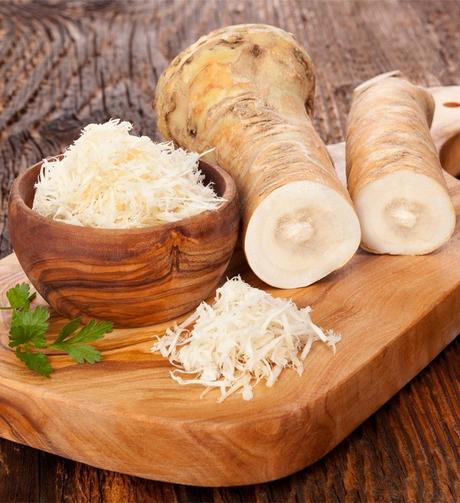
Horseradish has a pungent flavor and a sharp, spicy smell that is so potent that only one tablespoon of grated or sliced horseradish is enough to make you cry.
But, unlike other spices whose heat is often difficult to get rid of from your mouth, the reaction to the pungent horseradish's heat lasts for a short time only. This also makes horseradish a very interesting ingredient to add to different dishes. Recreate the distinct flavor profile and effect of horseradish with these useful horseradish substitutes!
1. Mustard
Brown mustard has a yellowish-brown color, a tinge of bitterness, and a strong pungent flavor. Its similarity in pungency, heat, texture, and color to horseradish makes it an excellent substitute for the original ingredient.
While not all types of mustard have a pungent flavor, brown mustard offers just the right amount of heat to use as a replacement for horseradish. And although you can easily substitute it in a 1:1 ratio, keep in mind that brown mustard contains vinegar, so it will impart an acidic flavor to your food.
1 teaspoon freshly grated horseradish = 1 teaspoon brown mustard.
2. Ground Mustard Seeds
Mustard seeds have a pungent flavor and a subtle, spicy aroma that is enhanced when ground coarsely using a mortar and pestle. This powder will have a flavor and texture similar to freshly grated horseradish.
But, remember, unlike your store-bought mustard, ground mustard seeds will have a very intense, concentrated flavor. If your recipe calls for ground horseradish, make a paste with two parts ground mustard powder and one part water, and then use it in dishes as required to achieve a similar flavor profile.
1 teaspoon freshly grated horseradish = 1/2 teaspoon mustard seed paste. (Start with this ratio and adjust to your liking.)
3. Wasabi and Wasabi Paste
Wasabi, like mustard, belongs to the same family as horseradish. It's made from the plant's rhizome, the part that grows underground, and has similar spiciness to horseradish. The difference between these two ingredients is so minimal that horseradish is often used to fake wasabi paste in low-end restaurants and eateries.
Keep in mind that wasabi is more bright than hot, bringing some floral notes and some mildness to the dish. It also has a distinct green color that may not be suitable for all recipes. However, if you don't mind the change in color, you'll find that its pungent flavor will complement your food just fine. As wasabi can pack a powerful flavor punch, start with a modest amount and modify according to taste.
1 teaspoon prepared horseradish = 1/2 teaspoon wasabi paste. (If making it from wasabi powder, use 2 parts wasabi powder and 1 part water.)
1 teaspoon freshly grated horseradish = 1 1/2 teaspoon freshly grated wasabi.
4. Fresh Ginger
Fresh ginger, a rhizome, has a pungent flavor and a strong aroma and packs an earthy, peppery heat. It can be used in almost any recipe to enhance the flavor and offer a nice kick of heat. It's also easy to find in most stores.
You can use fresh ginger in place of horseradish to recreate a similar flavor and texture. Keep in mind that fresh ginger does not have the same level of spiciness as horseradish and also has a slight sweetness to it that may not work in all dishes. So, you might need to add a little extra to get the peppery flavor of horseradish, but don't overdo it because it will change the overall flavor of your dish.
1 teaspoon freshly grated horseradish = 1 teaspoon freshly grated ginger.
5. Black Radish
In its raw form, black radish is pungent, earthy, spicy, and bitter, but it mellows into a subtly sweet flavor with peppery undertones when cooked. Black radish can be hard to come by, but if you can find it in an Asian or specialty store, you can substitute it for horseradish in dishes.
Because its dark-colored skin carries the majority of the heat, grating it with the skin intact will add a powerful pungency and heat to the meal, but it will also change the color. If you want a milder flavor, you can remove the skin before grating it. This will solve the color issue too, as black radish has a white flesh similar to horseradish.
1 teaspoon freshly grated horseradish = 1 teaspoon freshly grated black radish.
6. Horseradish Sauce
Horseradish sauce is made with grated horseradish root and a couple of other ingredients that give it a strong and spicy taste. Because horseradish is the main ingredient in this packaged product, it can easily be substituted for the original ingredient in a pinch.
Keep in mind that the horseradish sauce is produced using a cream base, so it will not share a near likeness with the flavor profiles of the original ingredient and will also alter the texture of the prepared dish. It also contains vinegar, which can reduce its potency even more. So, use more than a 1:1 substitute and taste and test as you go to achieve the desired results. You can also make it at home with this recipe.
1 teaspoon freshly grated horseradish = 1 1/2 teaspoon horseradish sauce.
7. Daikon
Daikon, also called winter radish, has a tangy, crisp, and mild flavor, a juicy texture, and distinctive sweetness. Although it is milder than horseradish, it can still be substituted for the original ingredient.
The mild flavor of daikon shines best in soups and stews, and it pairs nicely with meals that could benefit from a less spicy alternative to horseradish. You can use it in cooking preparations in an equal ratio, then taste it and adjust according to your preferences. It's also delicious served raw as an appetizer or side dish or layered on top of sandwiches and slaws for a crunchy meal.
1 teaspoon freshly grated horseradish = 1 teaspoon daikon.
